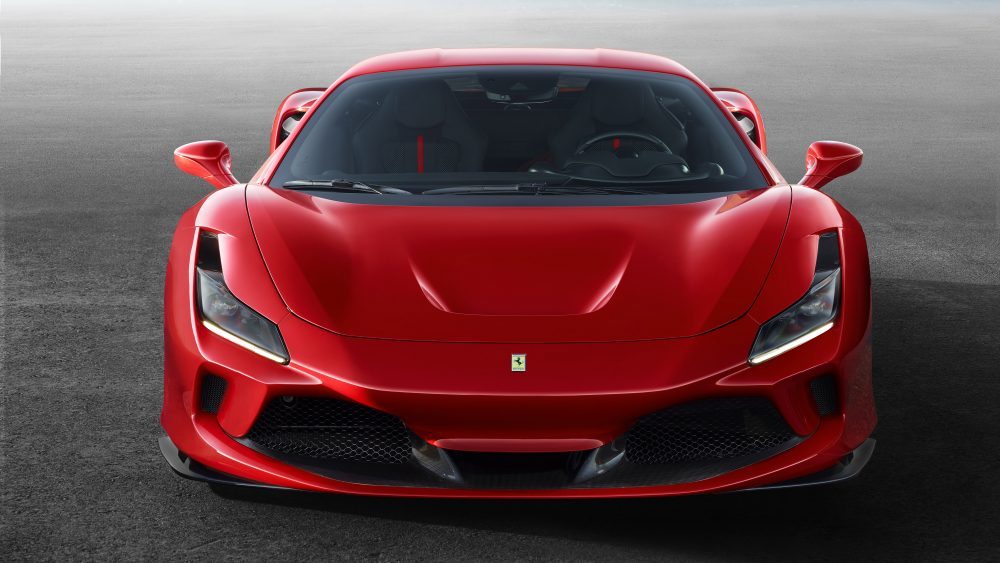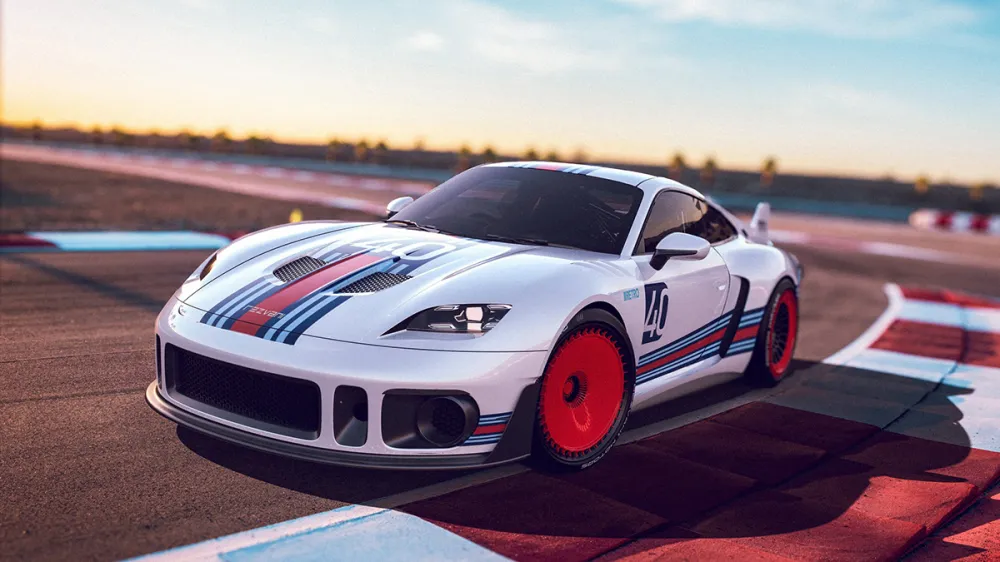
How Ferrari Created the New F8 Tributo, According to the Men Who Made It
Ferrari’s chief technology officer and design director detail why the V8 variant is a touchstone of future models.
Related articles
Ferrari’s F8 Tributo is the latest in a glorious line of mid-engine, eight-cylinder stallions that have defined the popular image of the brand since 1975, when the 308 Gran Turismo Berlinetta (GTB) was introduced. Look no further than the Magnum P.I. television series to confirm cultural impact: Tom Selleck drove a 308 variant in the top-rated 1980s original, and Jay Hernandez pedals a Ferrari 488 Spider in the show’s recent reboot.
Compared with the outgoing 488, F8 Tributo—that debuted at Geneva in early March—is lighter, more aerodynamically slippery, more powerful and blessed with new electronics that elevate cornering capabilities.
“F8 Tributo weighs an impressive 40 kilograms less than the 488 GTB,” says Michael Leiters, Ferrari’s chief technology officer. “The biggest area is the engine where, with the adoption of the same power unit as in the 488 Pista, we were able to shed 18kg thanks to the adoption, for example, of Inconel exhaust headers, titanium con-rods and a lightweight optimized flywheel.”

Ferrari F8 Tributo
Photo: Courtesy of Ferrari
To improve on-road driving, the engine has slightly different calibration compared to the narrowly track-focused Pista. Saving 18 kilograms from an engine already so compact and light is an accomplishment that almost defies understanding. Inconel has been with us for more than 80 years, but newly developed forms of this super-alloy are ideal for use in ultra-high-temperature applications. SpaceX has developed a version for use in rocket engines. Titanium connecting rods lower the weight of the moving parts, and that means revs rise and fall that little bit quicker in F8 Tributo.
“Other weight-saving moves include a carbon-fibre rear spoiler, lighter polycarbonate front and rear bumpers, and the rear screen formed in Lexan instead of glass, which saves nearly five kilos,” says Leiters.
Less weight combined with 36.5 more kilowatts than the 488 equals stirring performance. If the 488 had virtually no perceptible turbo lag, then this version will essentially have none. Instant access to power, instant access to the pleasures of acceleration.

The artful and aerodynamic F8 Tributo, Ferrari’s shape of things to come.
Photo: Courtesy of Ferrari.
Tributo, in Launch Control, can hit 100km/h in 2.9 seconds, 200 km/h in 7.8 seconds and should come within an angel’s breath of 10 seconds flat in, the quarter mile. In Tributo, Ferrari’s twin-turbo 3902cc V8 spools up 529kW. That’s 135kW per litre, the highest specific output ever for a road-going “mainstream” Ferrari V8. But Ferraris are not measured merely with numbers—a Ferrari will always offer a cohesive and visceral experience unlike any other car.
“The Ferrari Dynamic Enhancer [FDE] integrated into the car’s vehicle dynamic controls makes oversteer [tail-out] maneuvers easier to control on the limit,” says Leiters. “It was first introduced on the 488 Pista,” a road car produced last year that is narrowly focused for on-track capability, an extremist example of the 488 that pioneered technologies now part of Tributo. Adds Leiters, “For F8 Tributo, we reworked the FDE with a broader range of driver ability in mind. The FDE function is now available in the ‘Race’ setting of the manettino, allowing less expert drivers to control oversteer at slower vehicle speeds.” FDE will help less practiced drivers maintain control while dancing close to the edge of the performance envelope.

A pilot’s perspective behind the newly designed steering wheel.
Photo: Courtesy of Ferrari.
Ferrari cascades Formula One engineering, particularly aerodynamics, to its production cars. According to Leiters, “The S-duct was introduced on the 2008 F1 car. It’s a dynamic intake behind the front wing of the F1 cars, from under the nose to the upper surface of the chassis. It improves how the airflow generates downforce over the wing. Ferrari patented this solution when it was first employed on a road car: the 488 Pista. The F8 Tributo’s S-duct utilizes a channel from the bumper to the bonnet, where the calibrated section of the duct accelerates the airflow to increase downforce over the front thanks to the momentum change. In F8 Tributo, it contributes 15 per cent to the overall increase of downforce of the F8 over the 488 GTB.”

Michael Leiters, Ferrari’s chief technology officer.
Flavio Manzoni, director of Ferrari Design must balance the expected beauty of a Ferrari with the fact the body surface is in every way a highly technical aerodynamic tool. Because of the Scuderia’s efforts in Formula 1, few companies know as much about aerodynamics as Ferrari.
“The F8 Tributo is the latest technical and design evolution of the Ferrari mid-engined berlinetta and hails a significant transition in the run-up to the launch of a new generation of hybrid cars,” says Manzoni. “In that regard, the design is particularly relevant from a language perspective. Certain elements, in fact, reveal the presence of features optimized not merely for the increased efficiency and overall performance, but also to usher in a new formal evolution.”

Flavio Manzoni, director of Ferrari Design.
Photo: Courtesy of Ferrari.
“First and foremost,” says Manzoni, “there’s the new layout of the front of the car, spanning compact horizontal headlights, and ample air intakes and splitters which channel the air flows, sculpting the form of the bodywork. A design that simultaneously enhances functional demands and Ferrari styling elements, using a neat balance of concave and convex surfaces. There is also a sense of coherency with those styling elements and how they are reinterpreted along the flanks with taut lines and harmoniously balanced volumes, and the sinuous, muscular forms of the front and rear wheel arches.”
“Another notable element is the profile of the very tip of the front hood that almost appears as if it is floating, marking a separation between the upper and lower sections of the car, an impression further accentuated by the presence of the central S-Duct,” continues Manzoni. “The treatment of the rear is equally harmonious: the Lexan rear screen incorporates functional louvres which reference the F40 as well, conceptually citing the works of [spatial artist] Lucio Fontana. This rear screen, in fact, plays both a visual and a technological role that is reiterated by the lower engine bay air vents and the structure of the diffuser, which essentially define the overall architecture along with the twin circular rear lights, one of the classic Ferrari touches.

Unveiling the Tributo at the Geneva International Motor Show.
Photo: Courtesy of Ferrari.
Enrico Galliera, chief commercial and marketing officer, is succinct: “The mid-rear-engined V8 berlinetta has played a pivotal role since 1975. The seminal 308 GTB marked a new genre in the automotive field and we have constantly evolved the model with an unparalleled level of technological innovation combined with constant carry-over from F1 and our GT racing cars.”
Like the 458 Italia and 488, the F8 Tributo is a dynamic and visual triumph—a measuring stick of the supercar universe for years to come.
Subscribe to the Newsletter
Recommended for you
8 Fascinating Facts You Didn’t Know About Aston Martin
The British sports car company is most famous as the vehicle of choice for James Bond, but Aston Martin has an interesting history beyond 007.
May 1, 2024
Rezvani Will Rebuild Your 911 to Go From Zero to 100 in Two Seconds
The shop will build a version of the RR1 based on the Carrera S, GT3, and Turbo S
By Bryan Hood
April 23, 2024
You may also like.
You may also like.
Watch of the Week: TAG Heuer Formula 1 | Kith
The legendary sports watch returns, but with an unexpected twist.
Over the last few years, watch pundits have predicted the return of the eccentric TAG Heuer Formula 1, in some shape or form. It was all but confirmed when TAG Heuer’s heritage director, Nicholas Biebuyck, teased a slew of vintage models on his Instagram account in the aftermath of last year’s Watches & Wonders 2023 in Geneva. And when speaking with Frédéric Arnault at last year’s trade fair, the former CEO asked me directly if the brand were to relaunch its legacy Formula 1 collection, loved by collectors globally, how should they go about it?
My answer to the baited entreaty definitely didn’t mention a collaboration with Ronnie Fieg of Kith, one of the world’s biggest streetwear fashion labels. Still, here we are: the TAG Heuer Formula 1 is officially back and as colourful as ever.
As the watch industry enters its hype era—in recent years, we’ve seen MoonSwatches, Scuba Fifty Fathoms, and John Mayer G-Shocks—the new Formula 1 x Kith collaboration might be the coolest yet.

Here’s the lowdown: overnight, TAG Heuer, together with Kith, took to socials to unveil a special, limited-edition collection of Formula 1 timepieces, inspired by the original collection from the 1980s. There are 10 new watches, all limited, with some designed on a stainless steel bracelet and some on an upgraded rubber strap; both options nod to the originals.
Seven are exclusive to Kith and its global stores (New York, Los Angeles, Miami, Hawaii, Tokyo, Toronto, and Paris, to be specific), and are made in an abundance of colours. Two are exclusive to TAG Heuer; and one is “shared” between TAG Heuer and Kith—this is a highlight of the collection, in our opinion. A faithful play on the original composite quartz watch from 1986, this model, limited to just 1,350 pieces globally, features the classic black bezel with red accents, a stainless steel bracelet, and that creamy eggshell dial, in all of its vintage-inspired glory. There’s no doubt that this particular model will present as pure nostalgia for those old enough to remember when the original TAG Heuer Formula 1 made its debut.

Of course, throughout the collection, Fieg’s design cues are punctuated: the “TAG” is replaced with “Kith,” forming a contentious new brand name for this specific release, as well as Kith’s slogan, “Just Us.”
Collectors and purists alike will appreciate the dedication to the original Formula 1 collection: features like the 35mm Arnite cases—sourced from the original 80s-era supplier—the form hour hand, a triangle with a dot inside at 12 o’clock, indices that alternate every quarter between shields and dots, and a contrasting minuterie, are all welcomed design specs that make this collaboration so great.
Every TAG Heuer Formula 1 | Kith timepiece will be presented in an eye-catching box that complements the fun and colour theme of Formula 1 but drives home the premium status of this collaboration. On that note, at $2,200 a piece, this isn’t exactly an approachable quartz watch but reflects the exclusive nature of Fieg’s Kith brand and the pieces he designs (largely limited-edition).

So, what do we think? It’s important not to understate the significance of the arrival of the TAG Heuer Formula 1 in 1986, in what would prove integral in setting up the brand for success throughout the 90’s—it was the very first watch collection to have “TAG Heuer” branding, after all—but also in helping to establish a new generation of watch consumer. Like Fieg, many millennial enthusiasts will recall their sentimental ties with the Formula 1, often their first timepiece in their horological journey.
This is as faithful of a reissue as we’ll get from TAG Heuer right now, and budding watch fans should be pleased with the result. To TAG Heuer’s credit, a great deal of research has gone into perfecting and replicating this iconic collection’s proportions, materials, and aesthetic for the modern-day consumer. Sure, it would have been nice to see a full lume dial, a distinguishing feature on some of the original pieces—why this wasn’t done is lost on me—and perhaps a more approachable price point, but there’s no doubt these will become an instant hit in the days to come.
—
The TAG Heuer Formula 1 | Kith collection will be available on Friday, May 3rd, exclusively in-store at select TAG Heuer and Kith locations in Miami, and available starting Monday, May 6th, at select TAG Heuer boutiques, all Kith shops, and online at Kith.com. To see the full collection, visit tagheuer.com
You may also like.
8 Fascinating Facts You Didn’t Know About Aston Martin
The British sports car company is most famous as the vehicle of choice for James Bond, but Aston Martin has an interesting history beyond 007.
Aston Martin will forever be associated with James Bond, ever since everyone’s favourite spy took delivery of his signature silver DB5 in the 1964 film Goldfinger. But there’s a lot more to the history of this famed British sports car brand beyond its association with the fictional British Secret Service agent.
Let’s dive into the long and colourful history of Aston Martin.
You may also like.
What Venice’s New Tourist Tax Means for Your Next Trip
The Italian city will now charge visitors an entry fee during peak season.
Visiting the Floating City just got a bit more expensive.
Venice is officially the first metropolis in the world to start implementing a day-trip fee in an effort to help the Italian hot spot combat overtourism during peak season, The Associated Press reported. The new program, which went into effect, requires travellers to cough up roughly €5 (about $AUD8.50) per person before they can explore the city’s canals and historic sites. Back in January, Venice also announced that starting in June, it would cap the size of tourist groups to 25 people and prohibit loudspeakers in the city centre and the islands of Murano, Burano, and Torcello.
“We need to find a new balance between the tourists and residents,’ Simone Venturini, the city’s top tourism official, told AP News. “We need to safeguard the spaces of the residents, of course, and we need to discourage the arrival of day-trippers on some particular days.”
During this trial phase, the fee only applies to the 29 days deemed the busiest—between April 25 and July 14—and tickets will remain valid from 8:30 am to 4 pm. Visitors under 14 years of age will be allowed in free of charge in addition to guests with hotel reservations. However, the latter must apply online beforehand to request an exemption. Day-trippers can also pre-pay for tickets online via the city’s official tourism site or snap them up in person at the Santa Lucia train station.
“With courage and great humility, we are introducing this system because we want to give a future to Venice and leave this heritage of humanity to future generations,” Venice Mayor Luigi Brugnaro said in a statement on X (formerly known as Twitter) regarding the city’s much-talked-about entry fee.
Despite the mayor’s backing, it’s apparent that residents weren’t totally pleased with the program. The regulation led to protests and riots outside of the train station, The Independent reported. “We are against this measure because it will do nothing to stop overtourism,” resident Cristina Romieri told the outlet. “Moreover, it is such a complex regulation with so many exceptions that it will also be difficult to enforce it.”
While Venice is the first city to carry out the new day-tripper fee, several other European locales have introduced or raised tourist taxes to fend off large crowds and boost the local economy. Most recently, Barcelona increased its city-wide tourist tax. Similarly, you’ll have to pay an extra “climate crisis resilience” tax if you plan on visiting Greece that will fund the country’s disaster recovery projects.
You may also like.
Omega Reveals a New Speedmaster Ahead of the Paris 2024 Olympics
Your first look at the new Speedmaster Chronoscope, designed in the colour theme of the Paris Olympics.
The starters are on the blocks, and with less than 100 days to go until the Paris 2024 Olympics, luxury Swiss watchmaker Omega was bound to release something spectacular to mark its bragging rights as the official timekeeper for the Summer Games. Enter the new 43mm Speedmaster Chronoscope, available in new colourways—gold, black, and white—in line with the colour theme of the Olympic Games in Paris this July.
So, what do we get in this nicely-wrapped, Olympics-inspired package? Technically, there are four new podium-worthy iterations of the iconic Speedmaster.

The new versions present handsomely in stainless steel or 18K Moonshine Gold—the brand’s proprietary yellow gold known for its enduring shine. The steel version has an anodised aluminium bezel and a stainless steel bracelet or vintage-inspired perforated leather strap. The Moonshine Gold iteration boasts a ceramic bezel; it will most likely appease Speedy collectors, particularly those with an affinity for Omega’s long-standing role as stewards of the Olympic Games.
Notably, each watch bears an attractive white opaline dial; the background to three dark grey timing scales in a 1940s “snail” design. Of course, this Speedmaster Chronoscope is special in its own right. For the most part, the overall look of the Speedmaster has remained true to its 1957 origins. This Speedmaster, however, adopts Omega’s Chronoscope design from 2021, including the storied tachymeter scale, along with a telemeter, and pulsometer scale—essentially, three different measurements on the wrist.
While the technical nature of this timepiece won’t interest some, others will revel in its theatrics. Turn over each timepiece, and instead of a transparent crystal caseback, there is a stamped medallion featuring a mirror-polished Paris 2024 logo, along with “Paris 2024” and the Olympic Rings—a subtle nod to this year’s games.
Powering this Olympiad offering—and ensuring the greatest level of accuracy—is the Co-Axial Master Chronometer Calibre 9908 and 9909, certified by METAS.

A Speedmaster to commemorate the Olympic Games was as sure a bet as Mondo Deplantis winning gold in the men’s pole vault—especially after Omega revealed its Olympic-edition Seamaster Diver 300m “Paris 2024” last year—but they delivered a great addition to the legacy collection, without gimmickry.
However, the all-gold Speedmaster is 85K at the top end of the scale, which is a lot of money for a watch of this stature. By comparison, the immaculate Speedmaster Moonshine gold with a sun-brushed green PVD “step” dial is 15K cheaper, albeit without the Chronoscope complications.
—
The Omega Speedmaster Chronoscope in stainless steel with a leather strap is priced at $15,725; stainless steel with steel bracelet at $16,275; 18k Moonshine Gold on leather strap $54,325; and 18k Moonshine Gold with matching gold bracelet $85,350, available at Omega boutiques now.
Discover the collection here
You may also like.
Here’s What Goes Into Making Jay-Z’s $1,800 Champagne
We put Armand de Brignac Blanc de Noirs Assemblage No. 4 under the microsope.
In our quest to locate the most exclusive and exciting wines for our readers, we usually ask the question, “How many bottles of this were made?” Often, we get a general response based on an annual average, although many Champagne houses simply respond, “We do not wish to communicate our quantities.” As far as we’re concerned, that’s pretty much like pleading the Fifth on the witness stand; yes, you’re not incriminating yourself, but anyone paying attention knows you’re probably guilty of something. In the case of some Champagne houses, that something is making a whole lot of bottles—millions of them—while creating an illusion of rarity.
We received the exact opposite reply regarding Armand de Brignac Blanc de Noirs Assemblage No. 4. Yasmin Allen, the company’s president and CEO, told us only 7,328 bottles would be released of this Pinot Noir offering. It’s good to know that with a sticker price of around $1,800, it’s highly limited, but it still makes one wonder what’s so exceptional about it.
Known by its nickname, Ace of Spades, for its distinctive and decorative metallic packaging, Armand de Brignac is owned by Louis Vuitton Moët Hennessy and Jay-Z and is produced by Champagne Cattier. Each bottle of Assemblage No. 4 is numbered; a small plate on the back reads “Assemblage Four, [X,XXX]/7,328, Disgorged: 20 April, 2023.” Prior to disgorgement, it spent seven years in the bottle on lees after primary fermentation mostly in stainless steel with a small amount in concrete. That’s the longest of the house’s Champagnes spent on the lees, but Allen says the winemaking team tasted along the way and would have disgorged earlier than planned if they’d felt the time was right.
Chef de cave, Alexandre Cattier, says the wine is sourced from some of the best Premier and Grand Cru Pinot Noir–producing villages in the Champagne region, including Chigny-les-Roses, Verzenay, Rilly-la-Montagne, Verzy, Ludes, Mailly-Champagne, and Ville-sur-Arce in the Aube département. This is considered a multi-vintage expression, using wine from a consecutive trio of vintages—2013, 2014, and 2015—to create an “intense and rich” blend. Seventy percent of the offering is from 2015 (hailed as one of the finest vintages in recent memory), with 15 percent each from the other two years.

This precisely crafted Champagne uses only the tête de cuvée juice, a highly selective extraction process. As Allen points out, “the winemakers solely take the first and freshest portion of the gentle cuvée grape press,” which assures that the finished wine will be the highest quality. Armand de Brignac used grapes from various sites and three different vintages so the final product would reflect the house signature style. This is the fourth release in a series that began with Assemblage No. 1. “Testing different levels of intensity of aromas with the balance of red and dark fruits has been a guiding principle between the Blanc de Noirs that followed,” Allen explains.
The CEO recommends allowing the Assemblage No. 4 to linger in your glass for a while, telling us, “Your palette will go on a journey, evolving from one incredible aroma to the next as the wine warms in your glass where it will open up to an extraordinary length.” We found it to have a gorgeous bouquet of raspberry and Mission fig with hints of river rock; as it opened, notes of toasted almond and just-baked brioche became noticeable. With striking acidity and a vein of minerality, it has luscious nectarine, passion fruit, candied orange peel, and red plum flavors with touches of beeswax and a whiff of baking spices on the enduring finish. We enjoyed our bottle with a roast chicken rubbed with butter and herbes de Provence and savored the final, extremely rare sip with a bit of Stilton. Unfortunately, the pairing possibilities are not infinite with this release; there are only 7,327 more ways to enjoy yours.


























